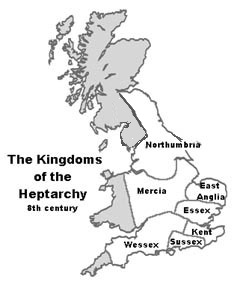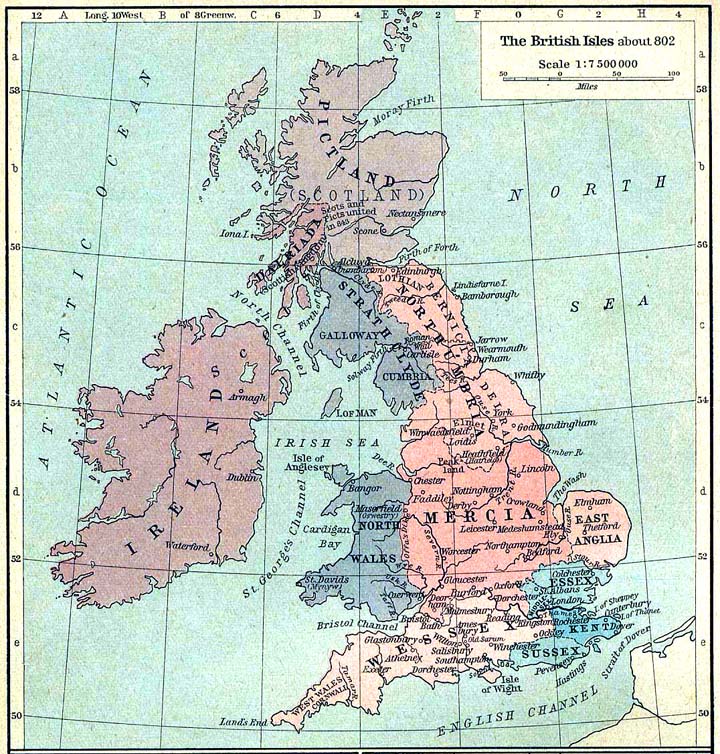The Seven Kingdoms
of the Heptarchy
As a result of the Anglo-Saxon invasions
of Britain, the country was broken up into a large number of tiny local
"kingdoms", each with its own king or sub-king, some of whom were really
little more than tribal chieftans. The situation was chaotic.
Eventually, seven main kingdoms evolved and smaller kingdoms were incorporated
into these seven main kingdoms; e.g., Bernicia and Deira became part of
Northumbria. The situation, however, was far from stable. There
was an unbroken succession of wars in which the various rulers sought to
eclipse and dominate their neighbours. Kings who achieved overall
dominance are remembered as a “Bretwalda” or “Ruler of Britain”.
 The first recorded Bretwalda was Aelle of Sussex circa 490. Next came Ceawlin
of Wessex, followed by Ethelbert of Kent and Rędwald of East Anglia.
The 7th century saw Northumbrian Bretwaldas; Mercian leaders achieved dominence
in the 8th century; and in A.D. 828, Ecgbert of Wessex was recognized as
the most powerful Bretwalda to date as the “Overlord of the Seven Kingdoms
of the Heptarchy”. The only kingdom that never produced a Bretwalda
was Essex.
The first recorded Bretwalda was Aelle of Sussex circa 490. Next came Ceawlin
of Wessex, followed by Ethelbert of Kent and Rędwald of East Anglia.
The 7th century saw Northumbrian Bretwaldas; Mercian leaders achieved dominence
in the 8th century; and in A.D. 828, Ecgbert of Wessex was recognized as
the most powerful Bretwalda to date as the “Overlord of the Seven Kingdoms
of the Heptarchy”. The only kingdom that never produced a Bretwalda
was Essex.
In the late 9th century, King Alfred
of Wessex (Alfred the Great) achieved a special status whereby he was the
first king to be recognised as a truly national leader. He did this
be demonstrating that a common enemy, the terrifying Danes, could be fought
and beaten. Alfred's great grandson Edgar the Peaceable was the first king
of a truly united England; but towards the end of Edgar's reign, circa
970, it became possible for small groups of Viking adventurers to establish
themselves on remote parts of the northern coast. Scarborough derives
its name from Thorgils "Skarthi" or "hare-lipped"; and his brother Kormak
"Fleinn" or "arrow" has his name preserved in Flamborough. At the
time of Ęthelred's accession circa 980, the Danish King Harold "Bluetooth"
Gormsson was firmly established in the north. King Harold's son was
Sweyn Forkbeard, father of King Canute.
The Danes were eventually victorious
and King Canute (ruled 1016-1035) was a welcome surprise. This reformed
Viking held up Edgar the Peaceable as his model, ordered the English to
obey Edgar’s laws and gave them a reign of national peace with honour excelling
not only that of Edgar but of any previous English king.
(scroll down for larger map)
. . . Richard Humble:
The Saxon Kings, London, 1980
. . . Sir Frank M. Stenton: Anglo-Saxon England,
2nd Editon, Oxford, 1947
The British Isles circa 802 (I'm not sure where this map came from . . . possibly a 1920's atlas.)
Please click to return to Ecgbert,
King of Wessex |
 The first recorded Bretwalda was Aelle of Sussex circa 490. Next came Ceawlin
of Wessex, followed by Ethelbert of Kent and Rędwald of East Anglia.
The 7th century saw Northumbrian Bretwaldas; Mercian leaders achieved dominence
in the 8th century; and in A.D. 828, Ecgbert of Wessex was recognized as
the most powerful Bretwalda to date as the “Overlord of the Seven Kingdoms
of the Heptarchy”. The only kingdom that never produced a Bretwalda
was Essex.
The first recorded Bretwalda was Aelle of Sussex circa 490. Next came Ceawlin
of Wessex, followed by Ethelbert of Kent and Rędwald of East Anglia.
The 7th century saw Northumbrian Bretwaldas; Mercian leaders achieved dominence
in the 8th century; and in A.D. 828, Ecgbert of Wessex was recognized as
the most powerful Bretwalda to date as the “Overlord of the Seven Kingdoms
of the Heptarchy”. The only kingdom that never produced a Bretwalda
was Essex.
